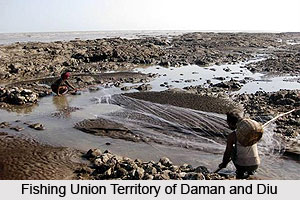 Agriculture is an important economy of Daman. About 3727 hectares of land are under cultivation. The important crops grown here are paddy, ragi, groundnut, pulses and beans, wheat, banana, sapota and mango. Through the provision of irrigation facilities double cropping has been introduced. The Damanganga Projectwhich is located in the Dadra and Nagar Haveli, is a joint venture of the state of Gujarat and Goa and the Union Territory of Daman and Diu and Dadra and Nagar Haveli. Fishing is also a main economic activity here. Cattle, buffaloes, sheep`s and goats are the main livestock.
Agriculture is an important economy of Daman. About 3727 hectares of land are under cultivation. The important crops grown here are paddy, ragi, groundnut, pulses and beans, wheat, banana, sapota and mango. Through the provision of irrigation facilities double cropping has been introduced. The Damanganga Projectwhich is located in the Dadra and Nagar Haveli, is a joint venture of the state of Gujarat and Goa and the Union Territory of Daman and Diu and Dadra and Nagar Haveli. Fishing is also a main economic activity here. Cattle, buffaloes, sheep`s and goats are the main livestock.
The principal occupation of the people in Diu are weaving and dyeing. The articles manufactured here are of great demand abroad. Most of the people here are engaged in fishing and salt production. The coastal and island waters are rich in fish as pomfret and hils, Bombay duck, prawns, shark, eel and Dara. The fishing industry has boosted canning and freezing, cloth. The handicraft articles are of high artistic value, manufactured from ivory, tortoise-shell and horns of animals. There is a unit in Diu where processing and canning of fish is done. Cattle, buffaloes, sheep and goats are main livestock of the district.
The people who live mostly in the upper storeys of lofty houses are quite industrious and hardworking. The main items of export are dried salt, fish, and coconuts. The total number of industrial units registered in Daman And Diu together are about 535. The main industrial areas of the union territory are Somnath, Dabhel, Bhimpore and Kadaiya.




















